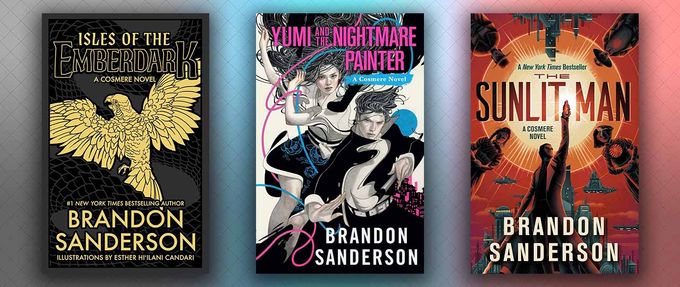Yumi and the Nightmare Painter is a standalone fantasy novel by Brandon Sanderson, set in his wider Cosmere universe. Personally, I think it’s one of his best works and well worth a read, regardless of whether you’re knee-deep in Cosmere lore or just a casual reader of fantasy and sci-fi. It charmingly blends a wholesome love story between two different people from two different worlds, with settings and aesthetics inspired by Japanese and Korean media. Depicting a clash of cultures and traditions, Sanderson explores themes of cooperation and solidarity as vital to the continued existence (and evolution) of communities. Deftly paced and thoroughly engaging, Yumi and the Nightmare Painter is a captivating and thought-provoking read.
The book was originally written during the COVID-19 pandemic and announced in 2022, as part of Sanderson’s “Secret Projects” campaign on Kickstarter—one of the most successful campaigns on the history of the platform. It’s a completely standalone novel, so you don’t need any prior knowledge of the Cosmere to enjoy this book, although familiarity with his other works will definitely help you spot the references and enhance the reading experience.
What is Yumi and the Nightmare Painter About?
Yumi and the Nightmare Painter follows two characters—Yumi and Nikaro—whose bodies get swapped. They must work together to save their communities. Yumi is a “yoki-hijo” from the city of Torio; she has the ability to call and bind spirits to do her bidding, by making complex stacks of rocks. Yumi’s life is one of obedience and discipline—she may not always enjoy her work but she never questions this “sacred calling” or the rigidity of her routines. On the other hand, Nikaro is a “Painter” from Kilahito—a city powered by “hion” lines—and his job is to keep the “nightmares” at bay via intricate painting techniques that traps the creatures and prevents them from hurting people. Nikaro is shy, introverted and aloof—a brooding figure fighting his own demons.
When their paths cross, their opposite personalities clash violently, and they initially find it hard to get along. Trapped in unfamiliar bodies, they nevertheless learn to trust each other, navigate different societies and slowly catch feelings for one another. Through their viewpoints, Sanderson is able to show off his worldbuilding skills, emphasizing how Torio and Kilahito are distinct from each other, even as the storylines converge in the most unexpected and satisfying of ways.
For those who’ve read the Mistborn and The Stormlight Archive books, the geography of this planet might seem utterly unfamiliar and that’s deliberately so. For inspiration, Sanderson turned to Japanese and Korean media like the manga Hikaru no Go, the anime movie Kimi no Nawa (Your Name) and the video game Final Fantasy X. There’s a lovely Studio Ghibli-like quality to this book, with vivid intrigue, delectable descriptions of cuisine, and two main characters overcoming their differences and helping each other grow while slowly falling for each other.
What are Yumi and the Nightmare Painter’s Connections to the Cosmere?
Since, Yumi and the Nightmare Painter is set in the Cosmere universe, it naturally has some connections and references to Sanderson’s other books. Most notably, this book (like Tress of the Emerald Sea) is narrated by Hoid—the worldhopping character who makes an appearance in almost all the Cosmere books. Sanderson eventually plans to give Hoid his own book (Dragonsteel) and in preparation for that, he is practicing writing in Hoid’s voice.
Moreover, the finale of Yumi and the Nightmare Painter where Yumi, against all odds, survives, throws some light on how Cognitive Shadows might work. Although the details are sparse, Yumi’s survival and continued existence might explain how Kelsier (from Mistborn) has also managed to survive (and change) as a Cognitive Shadow in Scadrial.
There are also minute references to other Cosmere books. For instance, readers of The Stormlight Archives will appreciate how Hoid compares rice grains on this planet to those on Roshar. He even mentions native flora and fauna of Roshar, including chulls and chasmfiends. Some of the spirits and creatures in this book seem comparable to the spren in The Stormlight Archives. Speaking of spren, Design (the Cryptic bonded to Hoid) is an important supporting character here, offering advice and helping Nikaro make sense of the strange happenings.
Yumi and the Nightmare Painter is also set in the far-future—there’s mention of a space station—so it might foreshadow how the future Mistborn books may turn out.
How Important Is Yumi and the Nightmare Painter to the Cosmere?
Overall, I’d say that Yumi and the Nightmare Painter is not that important to the Cosmere, particularly in terms of plot. While there are plenty of callbacks to the Cosmere, it doesn’t influence any of the ongoing storylines in the Mistborn or The Stormlight Archives series. There are no significant spoilers for Sanderson’s other works—if you haven’t read his other books, you might be mystified by a stray word or phrase, but that’s just about it. In fact, if you’re curious about the Cosmere but not ready to commit to the series, Yumi and the Nightmare Painter can give you a taste of Sanderson’s style and his strengths as a fantasy writer.
On the other hand, if you’re a devout Cosmere fan and up-to-date till The Rhythm of War and a very observant reader, you’ll certainly enjoy all the small Easter eggs and references to other books (including Elantris, Warbreaker, various novellas), especially in Hoid’s monologues or in his banter with Design.
So, if you haven’t yet read Yumi and the Nightmare Painter and you’re wondering whether or not you need a Cosmere catch-up—the choice is entirely up to you. Either way, it’s a brilliantly compelling book with a delicious slow-burn romance, intricate magic systems and a gripping plot, promising a richly rewarding reading experience.
